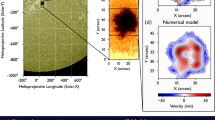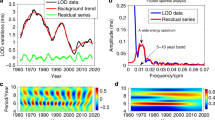Abstract
Classical helioseismology, which relies on acoustic waves, has been successfully applied to image the Sun’s interior rotation and structure. However, acoustic waves are insensitive to parameters such as magnetic fields, turbulent viscosity and entropy gradients in the deep convection zone, which are critical inputs to theories of solar dynamics. Inertial oscillations can bridge this gap with their complementary sensitivities to these parameters. Here, by employing helioseismic and correlation-tracking analyses of ground- and space-based observations, we detect equatorially antisymmetric vorticity waves, propagating retrograde at three times the phase speeds of Rossby–Haurwitz waves of the same wavenumber. This high-frequency dispersion relation cannot be explained by standard hydrodynamic mechanisms. We investigate three possibilities: that these vorticity waves are excited by the Coriolis force and modified by internal magnetic fields, gravity or compressibility. Incontrovertible identification of any of these coupled oscillations would influence our understanding of deep-interior magnetism, internal gravity oscillations or large-scale convection. Through observational evidence and theoretical arguments, however, we exclude these coupling mechanisms. The as-yet undetermined nature of these waves promises novel physics and fresh insight into solar dynamics.
This is a preview of subscription content, access via your institution
Access options
Access Nature and 54 other Nature Portfolio journals
Get Nature+, our best-value online-access subscription
$29.99 / 30 days
cancel any time
Subscribe to this journal
Receive 12 digital issues and online access to articles
$119.00 per year
only $9.92 per issue
Buy this article
- Purchase on Springer Link
- Instant access to full article PDF
Prices may be subject to local taxes which are calculated during checkout



Similar content being viewed by others
Data availability
The data that support the plots in this paper are available from the corresponding author upon reasonable request. The GONG+ global-mode times series (mrvmt_l) and the GONG++ ring-diagram flow maps (mrrng_l) are available at https://gong.nso.edu/. The HMI global-mode times series (hmi.v_sht_gf_72d) and ring-diagram flow maps (hmi.rdvflows_fd15) are available at http://jsoc.stanford.edu/ajax/lookdata.html. The HMI LCT flow maps are available upon request from B. Löptien (loeptien@mps.mpg.de).
Change history
12 April 2022
In the version of this article initially published, the x-axis label "Harmonic degree ℓ" was missing from Fig. 1d–g and Fig. 3a. The label has been restored in the HTML and PDF versions of the article.
References
Löptien, B. et al. Global-scale equatorial Rossby waves as an essential component of solar internal dynamics. Nat. Astron. 2, 568–573 (2018).
McIntosh, S. W., Cramer, W. J., Pichardo Marcano, M. & Leamon, R. J. The detection of Rossby-like waves on the Sun. Nat. Astron. 1, 0086 (2017).
Hathaway, D. H. & Upton, L. A. Hydrodynamic properties of the Sun’s giant cellular flows. Astrophys. J. 908, 160 (2021).
Gizon, L. et al. Solar inertial modes: observations, identification, and diagnostic promise. Astron. Astrophys. 652, L6 (2021).
Hanasoge, S. & Mandal, K. Detection of Rossby waves in the Sun using normal-mode coupling. Astrophys. J. Lett. 871, L32 (2019).
Proxauf, B. et al. Exploring the latitude and depth dependence of solar Rossby waves using ring-diagram analysis. Astron. Astrophys. 634, A44 (2020).
Hanson, C. S., Gizon, L. & Liang, Z.-C. Solar Rossby waves observed in GONG++ ring-diagram flow maps. Astron. Astrophys. 635, A109 (2020).
Christensen-Dalsgaard, J. Helioseismology. Rev. Mod. Phys. 74, 1073–1129 (2002).
Gizon, L. & Birch, A. C. Local helioseismology. Living Rev. Sol. Phys. 2, 6 (2005).
November, L. J. & Simon, G. W. Precise proper-motion measurement of solar granulation. Astrophys. J. 333, 427–442 (1988).
Proxauf, B. Observations of Large-Scale Solar Flows. PhD thesis, Max-Planck Institute for Solar System Research (2020).
Harvey, J. W. et al. The Global Oscillation Network Group (GONG) Project. Science 272, 1284–1286 (1996).
Schou, J. et al. Design and ground calibration of the Helioseismic and Magnetic Imager (HMI) instrument on the Solar Dynamics Observatory (SDO). Sol. Phys. 275, 229–259 (2012).
Woodard, M. F. Evidence for large-scale subsurface convection in the Sun. Mon. Not. R. Astron. Soc. 460, 3292–3297 (2016).
Hanasoge, S. M. Seismic sensitivity of normal-mode coupling to Lorentz stresses in the Sun. Mon. Not. R. Astron. Soc. 470, 2780–2790 (2017).
Hill, F. Rings and trumpets—three-dimensional power spectra of solar oscillations. Astrophys. J. 333, 996–1013 (1988).
Löptien, B. et al. Measuring solar active region inflows with local correlation tracking of granulation. Astron. Astrophys. 606, A28 (2017).
Corbard, T. et al. in GONG+ 2002. Local and Global Helioseismology: the Present and Future (ed. Sawaya-Lacoste, H.) 255–258 (ESA Special Publication Vol. 517, 2003).
Larson, T. P. & Schou, J. Improved helioseismic analysis of medium-ℓ data from the Michelson Doppler Imager. Sol. Phys. 290, 3221–3256 (2015).
Bogart, R. S., Baldner, C., Basu, S., Haber, D. A. & Rabello-Soares, M. C. HMI ring diagram analysis I. The processing pipeline. J. Phys. Conf. Ser. 271, 012008 (2011).
Bogart, R. S., Baldner, C., Basu, S., Haber, D. A. & Rabello-Soares, M. C. HMI ring diagram analysis II. Data products. J. Phys. Conf. Ser. 271, 012009 (2011).
Woodard, M. Detectability of large-scale solar subsurface flows. Sol. Phys. 289, 1085–1100 (2014).
Hindman, B. W., Haber, D. A. & Toomre, J. Subsurface circulations within active regions. Astrophys. J. 698, 1749–1760 (2009).
Anderson, E. R., Duvall, T. L. Jr. & Jefferies, S. M. Modeling of solar oscillation power spectra. Astrophys. J. 364, 699–705 (1990).
Toutain, T. & Appourchaux, T. Maximum likelihood estimators: an application to the estimation of the precision of helioseismic measurements. Astron. Astrophys. 289, 649–658 (1994).
Schou, J. et al. Helioseismic studies of differential rotation in the solar envelope by the Solar Oscillations Investigation using the Michelson Doppler Imager. Astrophys. J. 505, 390–417 (1998).
Kitchatinov, L. L. & Ruediger, G. Differential rotation in solar-type stars: revisiting the Taylor-number puzzle. Astron. Astrophys. 299, 446 (1995).
Hanasoge, S., Gizon, L. & Sreenivasan, K. R. Seismic sounding of convection in the Sun. Annu. Rev. Fluid Mech. 48, 191–217 (2016).
Miesch, M. S., Featherstone, N. A., Rempel, M. & Trampedach, R. On the amplitude of convective velocities in the deep solar interior. Astrophys. J. 757, 128 (2012).
Zaqarashvili, T. V. et al. Rossby waves in astrophysics. Space Sci. Rev. 217, 15 (2021).
Zaqarashvili, T. V., Oliver, R., Ballester, J. L. & Shergelashvili, B. M. Rossby waves in ‘shallow water’ magnetohydrodynamics. Astron. Astrophys. 470, 815–820 (2007).
Gachechiladze, T. et al. Magneto-Rossby waves in the solar tachocline and the annual variations in solar activity. Astrophys. J. 874, 162 (2019).
Yanai, M. & Maruyama, T. Stratospheric wave disturbances propagating over the equatorial Pacific. J. Meteorol. Soc. Jpn. II 44, 291–294 (1966).
Matsuno, T. Quasi-geostrophic motions in the equatorial area. J. Meteorol. Soc. Jpn. II 44, 25–43 (1966).
Christensen-Dalsgaard, J., Monteiro, M. J. P. F. G., Rempel, M. & Thompson, M. J. A more realistic representation of overshoot at the base of the solar convective envelope as seen by helioseismology. Mon. Not. R. Astron. Soc. 414, 1158–1174 (2011).
Gilman, P. A. & Glatzmaier, G. A. Compressible convection in a rotating spherical shell. I—Anelastic equations. II—A linear anelastic model. III—Analytic model for compressible vorticity waves. Astrophys. J. Suppl. 45, 335–388 (1981).
Busse, F. H. Convective flows in rapidly rotating spheres and their dynamo action. Phys. Fluids 14, 1301–1314 (2002).
Chelton, D. B. & Schlax, M. G. Global observations of oceanic Rossby waves. Science 272, 234–238 (1996).
Chelton, D. B., Schlax, M. G. & Samelson, R. M. Global observations of nonlinear mesoscale eddies. Prog. Oceanogr. 91, 167–216 (2011).
Hanasoge, S. Measurement process and inversions using helioseismic normal-mode coupling. Astrophys. J. 861, 46 (2018).
Basu, S., Antia, H. M. & Tripathy, S. C. Ring diagram analysis of near-surface flows in the Sun. Astrophys. J. 512, 458–470 (1999).
Löptien, B., Birch, A. C., Duvall, T. L., Gizon, L. & Schou, J. The shrinking Sun: a systematic error in local correlation tracking of solar granulation. Astron. Astrophys. 590, A130 (2016).
Liang, Z.-C., Gizon, L., Birch, A. C. & Duvall, T. L. Time–distance helioseismology of solar Rossby waves. Astron. Astrophys. 626, A3 (2019).
Acknowledgements
We thank P. Cally, T. L. Duvall Jr, L. Gizon, Z.-C. Liang, D. Mausumi, B. Proxauf, K. S. Smith and T. Zaqarashvili for insightful discussions. This research was carried out on the High Performance Computing resources at New York University Abu Dhabi and the computer centre at TIFR. The work utilizes data from the National Solar Observatory Integrated Synoptic Program, which is operated by the Association of Universities for Research in Astronomy, under a cooperative agreement with the National Science Foundation and with additional financial support from the National Oceanic and Atmospheric Administration, the National Aeronautics and Space Administration and the United States Air Force. The GONG network of instruments is hosted by the Big Bear Solar Observatory, High Altitude Observatory, Learmonth Solar Observatory, Udaipur Solar Observatory, Instituto de Astrofísica de Canarias and Cerro Tololo Inter-American Observatory. The HMI data are courtesy of NASA/SDO and the HMI Science Team. The HMI LCT maps are courtesy of B. Löptien. The Center for Space Science at NYU Abu Dhabi is funded by NYUAD institute grant G1502. S.H. acknowledges funding from the Department of Atomic Energy, India. K.R.S. and S.H. acknowledge support from the King Abdullah University of Science and Technology (KAUST) Office of Sponsored Research (OSR) under award OSR-CRG2020-4342. The Center for Space Science’s (NYUAD) Data Center was used in the preparation of the datasets.
Author information
Authors and Affiliations
Contributions
C.S.H. and S.H. designed and performed the research. C.S.H. performed the analysis on the ring-diagram and LCT data. S.H. performed the mode-coupling analysis and numerical studies. All authors drafted and contributed to the paper.
Corresponding author
Ethics declarations
Competing interests
The authors declare no competing interests.
Peer review
Peer review information
Nature Astronomy thanks the anonymous reviewers for their contribution to the peer review of this work.
Additional information
Publisher’s note Springer Nature remains neutral with regard to jurisdictional claims in published maps and institutional affiliations.
Supplementary information
Supplementary Information
Supplementary Figs. 1–9, Discussion Sections 1–10 and Table 1.
Rights and permissions
About this article
Cite this article
Hanson, C.S., Hanasoge, S. & Sreenivasan, K.R. Discovery of high-frequency retrograde vorticity waves in the Sun. Nat Astron 6, 708–714 (2022). https://doi.org/10.1038/s41550-022-01632-z
Received:
Accepted:
Published:
Issue Date:
DOI: https://doi.org/10.1038/s41550-022-01632-z
This article is cited by
-
Simulations of Solar and Stellar Dynamos and Their Theoretical Interpretation
Space Science Reviews (2023)
-
Dynamics of Large-Scale Solar Flows
Space Science Reviews (2023)
-
Hidden currents at the Sun’s surface
Nature Astronomy (2022)



